Greater and Lesser Clouds
© NASA Goddard
The Magellanic Clouds, named after the Portuguese navigator Ferdinand Magellan, were discovered during the first voyage around the world. These galaxies share a gaseous envelope about 22° apart near the south celestial pole. The Magellanic Clouds, consisting of the Large Magellanic Cloud (LMC) and the Small Magellanic Cloud (SMC), are irregular galaxies that orbit the Milky Way.
The LMC is a luminous patch approximately 5° in diameter, while the SMC is smaller, measuring less than 2° across. Visible in the Southern Hemisphere, these galaxies cannot be observed from most northern latitudes. The LMC is about 160,000 light-years away, and the SMC lies 190,000 light-years from Earth. They are smaller in diameter than the Milky Way, with the LMC being 14,000 light-years across and the SMC 7,000 light-years.
Formed around 13 billion years ago, the Magellanic Clouds have experienced several tidal encounters with each other and the Milky Way. They contain a mix of young and old stars, with one-star cluster hosting R136a1, the most massive known star. These galaxies are rich in stellar formation and evolution, providing a unique opportunity for studying active star formation processes. Notably, the Tarantula Nebula within the LMC is a vast ionized-hydrogen region with many young, hot stars, making it the largest ionized gas region in the Local Group of galaxies.
CHARACTERISTICS
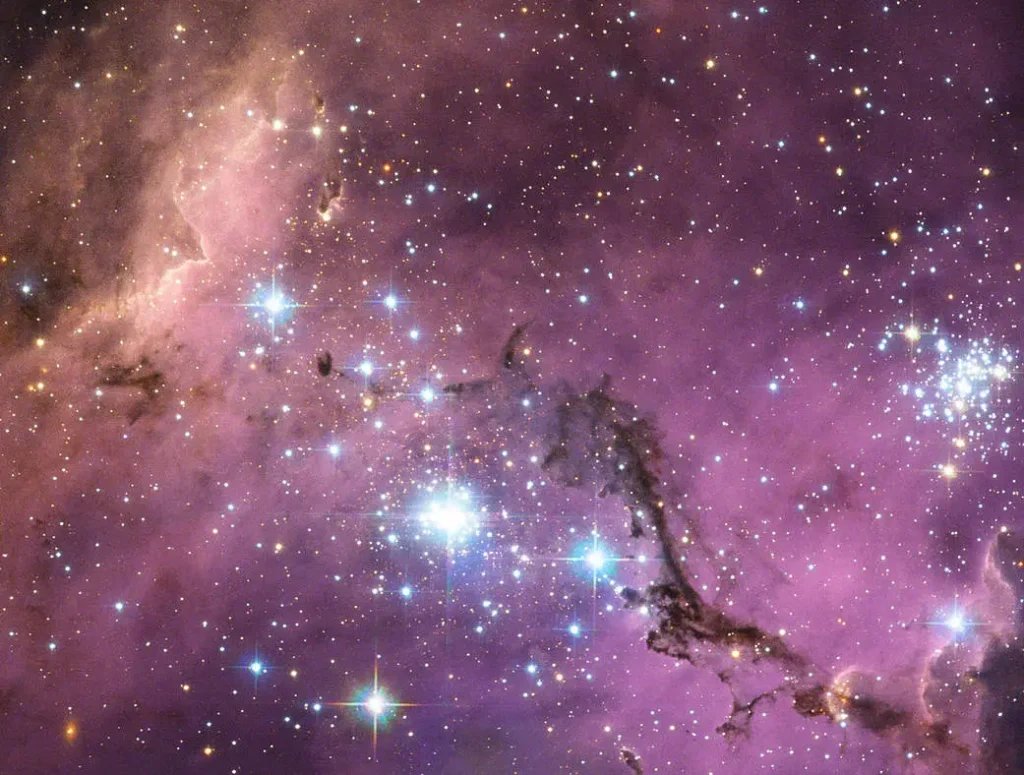
The Magellanic Clouds, also known as Nubeculae Magellani, consist of two irregular dwarf galaxies, the Large Magellanic Cloud (LMC) and the Small Magellanic Cloud (SMC), which are satellite galaxies of the Milky Way. Here are detailed characteristics of the Magellanic Clouds:
DISTANCE AND SIZE
The Magellanic Clouds in the southern celestial hemisphere are visible to the naked eye from the Southern Hemisphere and are among the closest galaxies to our own. They are roughly 160,000 light-years away. Despite their proximity compared to most other galaxies, they are still far enough that their light takes thousands of years to reach Earth.
The larger of the two is roughly 14,000 light-years in diameter, while the smaller one spans about 7,000 light-years. These galaxies contain numerous stars, nebulae, and star clusters, contributing significantly to the study of cosmic phenomena. Their irregular shapes are likely due to gravitational interactions with the Milky Way and each other.
MASS AND STRUCTURE
The Clouds differ significantly in mass and structure. Combined, their total mass is estimated to be around 10 billion solar masses. This mass includes both visible matter, such as stars and gas, and dark matter, which is inferred from their gravitational influence but not directly observed.
Structurally, these galaxies are highly irregular, lacking the defined shapes of spiral or elliptical galaxies. They feature a chaotic mix of stars, gas, and dust, with regions of intense star formation. Their irregularity is thought to result from gravitational interactions both with each other and with the Milky Way. This interaction likely triggers bursts of star formation and distorts their shapes.
These galaxies also contain prominent features such as the Magellanic Bridge, a stream of gas and stars connecting them, and the Magellanic Stream, a trailing extension of gas. These structures further illustrate the complex gravitational dynamics at play.
GAS-RICH AND METALLICITY
The Magellanic Clouds are noted for being gas-rich, containing substantial amounts of hydrogen, which fuels active star formation. This abundance of gas, both in atomic and molecular forms, is a defining characteristic, leading to the creation of new stars and nebulae. The regions within these galaxies are sites of vigorous star-forming activity, marked by bright, young star clusters and vast clouds of gas and dust.
In terms of metallicity, these galaxies have lower levels compared to the Milky Way. Metallicity refers to the abundance of elements heavier than hydrogen and helium, produced through stellar processes. The lower metallicity of the Magellanic Clouds suggests they are relatively younger and less evolved, having undergone fewer cycles of star formation and supernova explosions which enrich the interstellar medium with metals.
STAR FORMATION
These clouds exhibit vigorous star formation activity, significantly influenced by their rich reservoirs of gas and dynamic interactions. These galaxies host numerous regions where new stars are born, often marked by bright nebulae and dense star clusters. The abundance of hydrogen gas fuels this star formation, creating a fertile environment for the birth of new stars.
Interactions with the Milky Way and with each other play a crucial role in triggering star formation. Gravitational forces compress the gas within these galaxies, leading to the collapse of gas clouds and the initiation of star formation. This process results in the creation of various stellar nurseries, where clusters of young, hot stars illuminate surrounding gas and dust.
The Magellanic Clouds contain some of the most active star-forming regions in the local group of galaxies, serving as valuable laboratories for studying the processes involved. Observations reveal complex structures such as filaments and bubbles, indicative of ongoing and past star formation events. These observations help astronomers understand the lifecycle of stars, from their formation in dense gas clouds to their eventual evolution and impact on the surrounding environment.
ORBITAL DYNAMICS
The Magellanic Clouds engage in intricate orbital dynamics as they orbit the Milky Way, influenced by gravitational forces and interactions with each other and the Milky Way. Their orbits are not stable circles but rather complex paths shaped by gravitational tugs from nearby galaxies and the Milky Way’s massive halo of dark matter. These interactions cause the Magellanic Clouds’ orbits to be elliptical and inclined relative to the plane of the Milky Way.
The galaxies’ proximity to the Milky Way results in tidal forces that distort their shapes and may trigger bursts of star formation. Additionally, the gravitational influence of the Milky Way causes the Magellanic Clouds to slowly lose energy and spiral closer to our galaxy over time. This gradual infall is a dynamic process that contributes to the ongoing evolution of the Magellanic Clouds and the Milky Way itself.
The Magellanic Clouds also interact with each other, exerting gravitational forces that affect their orbits. This interaction may have led to the formation of features such as the Magellanic Bridge and the Magellanic Stream, long trails of gas, and stars connecting the two galaxies.
GRAVITATIONAL INTERACTIONS
The Magellanic Clouds engage in a complex dance of gravitational interactions, profoundly shaped by their interactions with each other and with the Milky Way. These interactions result from the mutual gravitational attraction between the Magellanic Clouds and the Milky Way, as well as the gravitational forces between the Magellanic Clouds themselves.
The gravitational pull of the Milky Way affects the orbits of the Magellanic Clouds, leading to their gradual infall towards our galaxy. This interaction also induces tidal forces, which can distort the shapes of the Magellanic Clouds and trigger episodes of star formation within them.
Additionally, the Magellanic Clouds exert gravitational forces on each other as they orbit the Milky Way. These interactions can lead to the formation of structures such as the Magellanic Bridge and the Magellanic Stream, long tidal tails of gas, and stars that connect the two galaxies.
COMPOSITION
LARGE MAGELLANIC CLOUDS
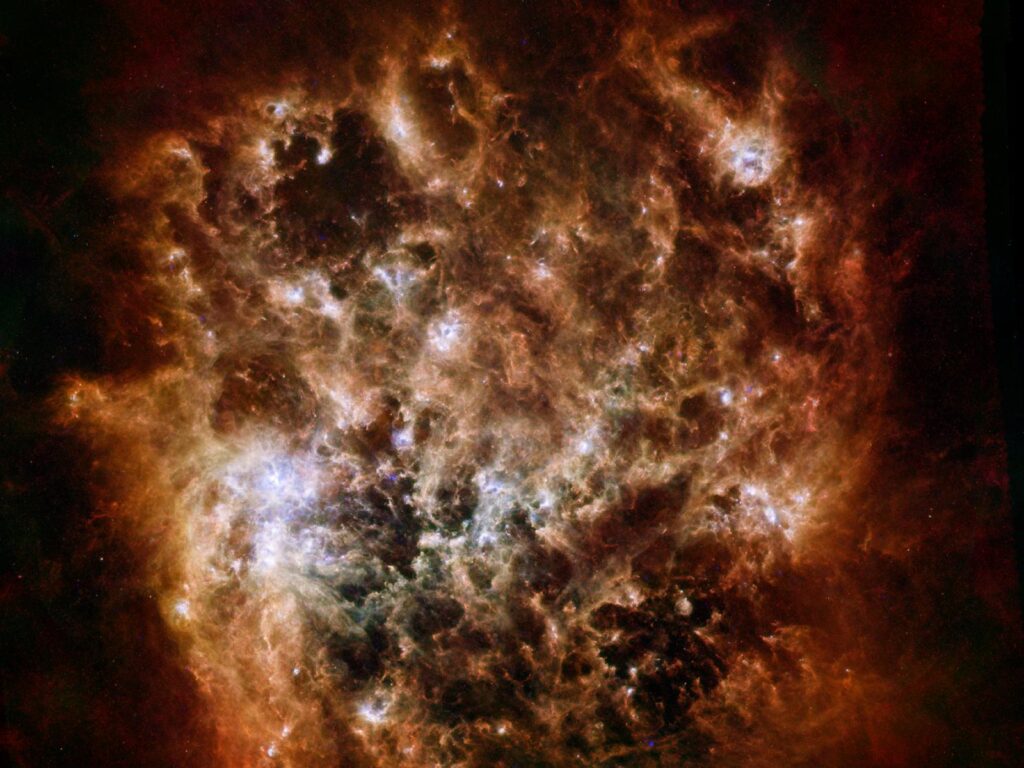
The Large Magellanic Cloud (LMC) is a dwarf galaxy located approximately 163,000 light-years from Earth. It is the fourth-largest galaxy in the Local Group after the Milky Way, Andromeda Galaxy, and Triangulum Galaxy. The LMC is classified as a Magellanic spiral galaxy and contains a prominent central bar and spiral arm. At a distance of around 50 kiloparsecs, the LMC is the second- or third-closest galaxy to the Milky Way, after the Sagittarius Dwarf Spheroidal and the possible dwarf irregular galaxy called the Canis Major Overdensity. The LMC is roughly one-hundredth the mass of the Milky Way and contains around 20 billion stars.
The LMC is visible as a faint “cloud” from the southern hemisphere of the Earth and from as far north as 20° N. It straddles the constellations Dorado and Mensa and has an apparent length of about 10° to the naked eye, 20 times the Moon‘s diameter, from dark sites away from light pollution. The cloud is an excellent laboratory for studying active stellar formation and evolution. It contains numerous young stars and star clusters, as well as some much older stars. One of these star clusters contains R136a1, the most massive star known, with a mass 265 times that of the Sun.
In 1987, the last supernova to be seen with the naked eye exploded in the LMC. The LMC was also the host galaxy to a supernova (SN 1987A), the brightest observed in over four centuries. Measurements with the Hubble Space Telescope have revealed that the LMC has a rotation period of 250 million years. The cloud is predicted to merge with the Milky Way in approximately 2.4 billion years. The gravity of the LMC has affected the Milky Way as well, distorting the outer parts of the galactic disk.
SMALL MAGELLANIC CLOUDS
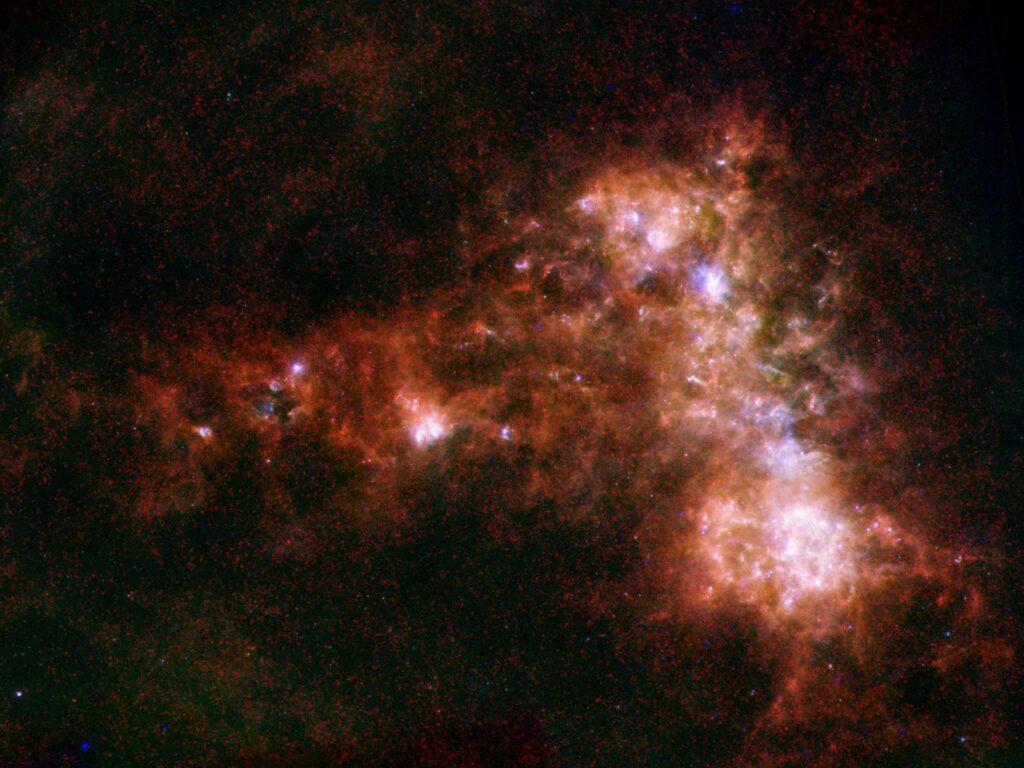
The Small Magellanic Cloud (SMC) is a dwarf galaxy located near the Milky Way, classified as a dwarf irregular galaxy with a total mass of approximately 7 billion solar masses. It contains several hundred million stars and has an isophotal diameter of about 5.78 kiloparsecs (18,900 light-years). The SMC is visible from the entire Southern Hemisphere and appears as a faint hazy patch resembling a detached piece of the Milky Way, with an average apparent diameter of about 4.2°.
The SMC is a satellite galaxy of the Milky Way and is one of the most distant objects visible to the naked eye, located approximately 200,000 light-years away. It forms a pair with the Large Magellanic Cloud (LMC) and is a member of the Local Group, a collection of about 30 galaxies in the same neighborhood. The SMC has a common envelope of neutral hydrogen with the LMC, indicating a long history of gravitational interaction between the two galaxies.
Recent studies suggest that the SMC may not be a single galaxy but two star-forming regions superimposed along our line of sight, separated by about 16,000 light-years. This new finding challenges the previous notion of the SMC as a single dwarf galaxy and proposes that it consists of two distinct star-forming systems with similar gas mass.
Studies have also revealed that the cloud is slowly losing gas, leading to a decline in star formation activity and a potential future merger with more massive objects like the Milky Way. Observations have shown a powerful outflow of hydrogen gas from the SMC, indicating a gradual fading away of the galaxy as it loses gas essential for star formation. Ultimately, the SMC is likely to be absorbed by the Milky Way in the distant future.
MAGELLANIC BRIDGE
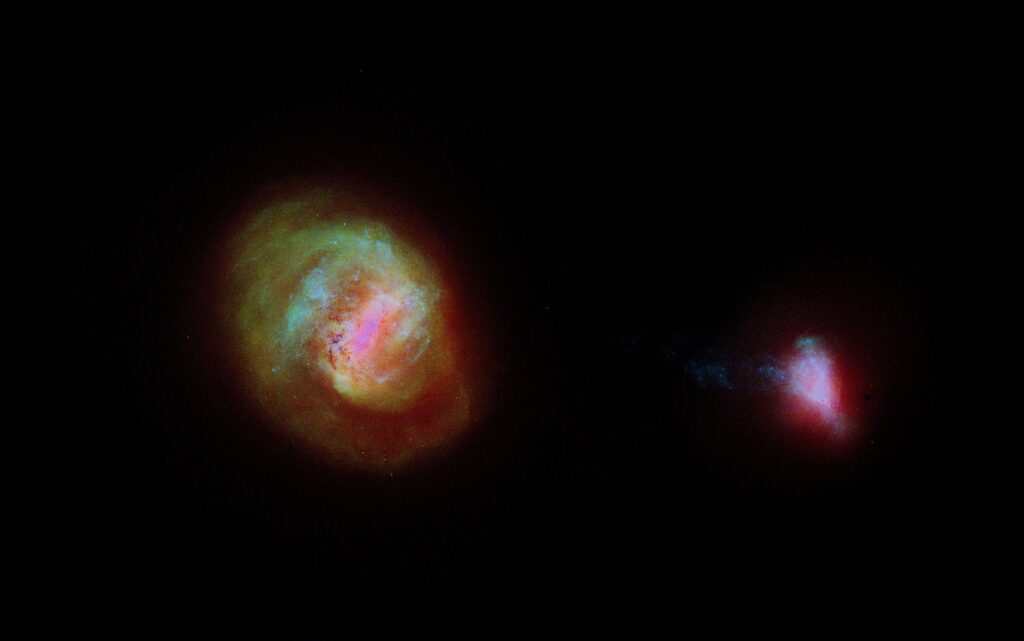
The Magellanic Bridge is a stream of neutral hydrogen gas and a few known stars that link the Large Magellanic Cloud (LMC) and the Small Magellanic Cloud (SMC). It is approximately 75,000 light-years long and was likely formed during a close encounter between the two dwarf galaxies around 200 million years ago.
Recent observations have revealed the presence of a continuous stream of stars throughout the Bridge, with a higher concentration in the western part. Two major density clumps have been identified, one near the SMC and the other midway between the galaxies, referred to as the “OGLE Island”. Astronomers have also discovered a magnetic field spanning the Magellanic Bridge, suggesting the existence of a “pan-Magellanic field” that encompasses both the LMC and SMC. This magnetic field may have been dragged into the Bridge along with the gas during the galaxies’ interaction.
The Magellanic Bridge is a unique laboratory for studying star formation in a low-metallicity environment. The recent discovery of O-type stars in the Bridge indicates that tidally stripped galactic tails containing low-density but highly dynamical gas are capable of producing massive stars. Analysis of the chemical abundances of these O stars suggests that the Bridge gas may have accreted during multiple episodes of tidal interaction between the Clouds. The lowest derived metal content is interpreted as the signature of primordial gas, potentially dating back several billion years.
MINI MAGALLENIC CLOUD
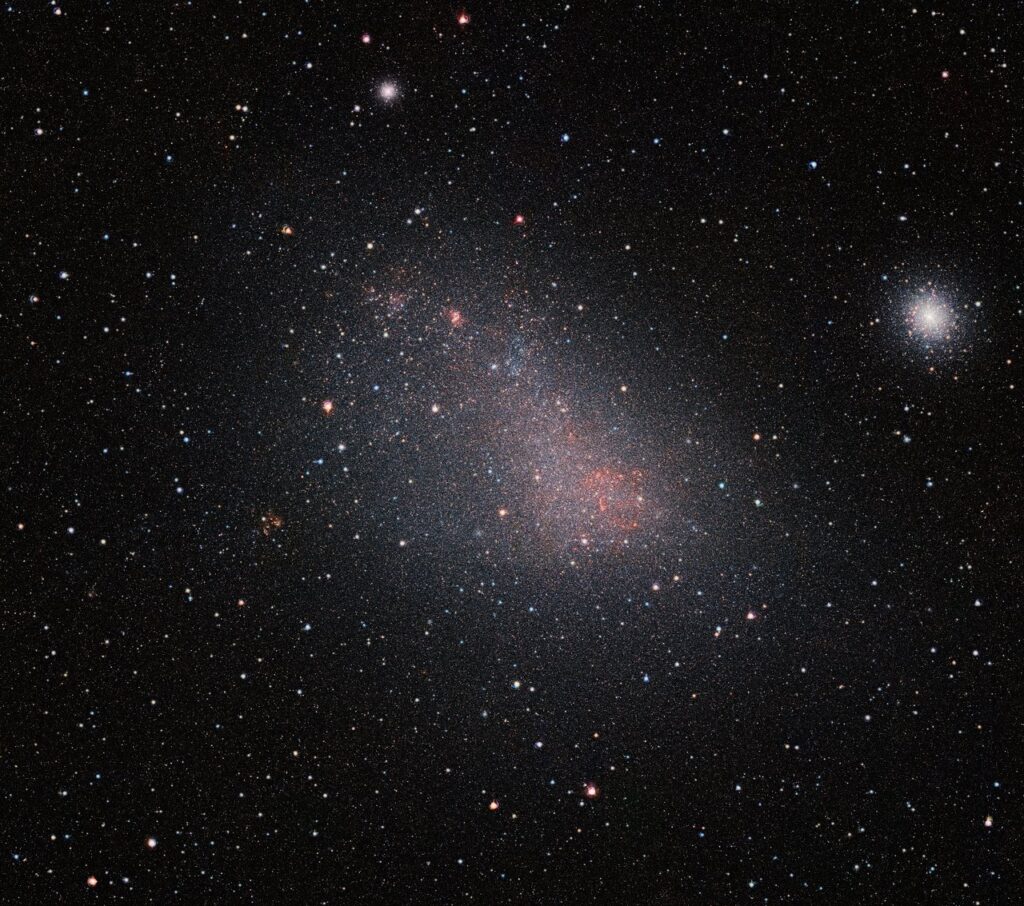
The Mini Magellanic Cloud (MMC) is a proposed smaller section of the Small Magellanic Cloud (SMC), located behind the main part of the SMC and separated by about 30,000 light-years. This hypothesis was put forward by astrophysicists D. S. Mathewson, V. L. Ford, and N. Visvanathan, suggesting that past interactions with the Large Magellanic Cloud (LMC) split the SMC into two distinct sections that are still moving apart.
Recent research in 2023 confirmed the existence of two separate structures within the SMC, each with distinct stellar and gaseous chemical compositions, separated by approximately 5 kiloparsecs. The closer part of the SMC lies about 196,000 light-years away, while the farther part is approximately 215,000 light-years away.
The Mini Magellanic Cloud presents a unique astronomical puzzle, with the front stellar system of the SMC exhibiting different metallicities and hosting most of the molecular gas, while the system behind shows distinct chemical compositions in both stars and gas. Scientists speculate that these two structures could be remnants of two separate galaxies or that the front portion represents the main galaxy while the rear portion may be a stellar bridge.
